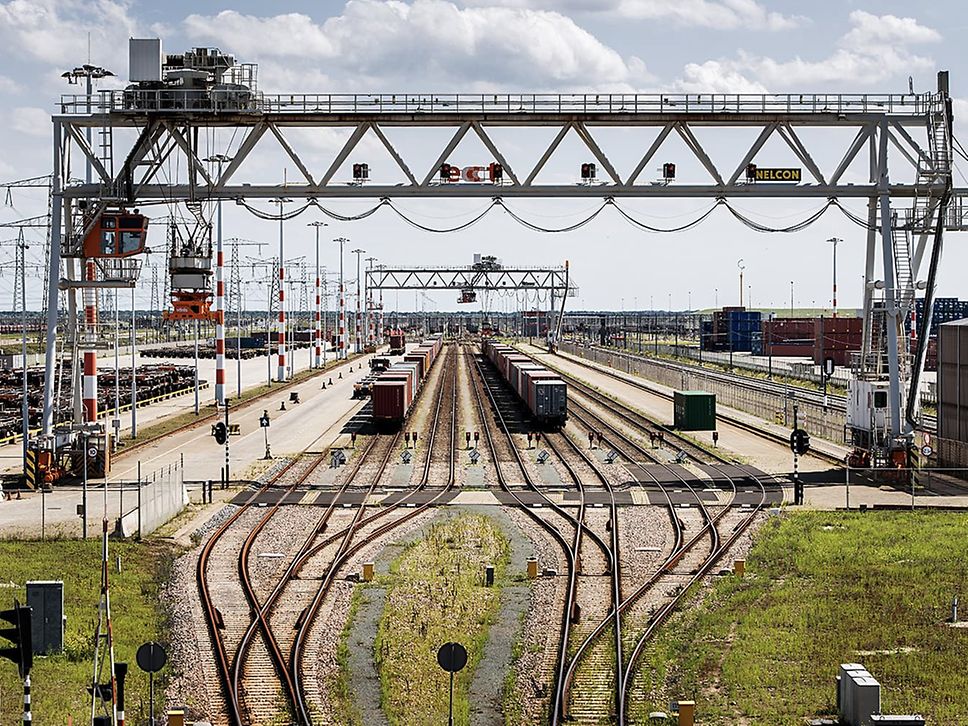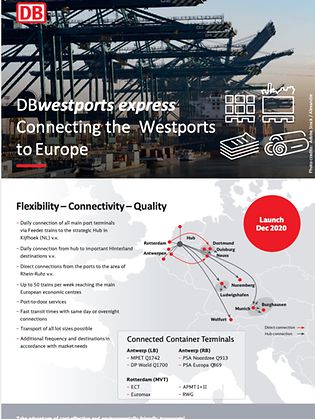Gateways to the European economy
The ports of Antwerp and Rotterdam are two of the most important transhipment yards in the world. When the timetable change took effect last December, DB Cargo expanded its network and opened the gates for all its customers – both literally and figuratively. Now the DBwestports express connects Europe’s two largest ports with their most important hinterland destinations in Germany and Vorarlberg.
In these two ports alone, some 27 million containers are transhipped each year, and the numbers continue to grow. That’s because the ports of Antwerp and Rotterdam have ambitious growth and sustainability targets, which they plan to reach primarily by expanding rail freight transport. The ports’ geographical location is their greatest advantage – after all, Antwerp and Rotterdam are the first ports of call for most large ships from overseas. Having a central location within Europe is also a point in their favour. That’s because roughly 60% of the EU’s purchasing power is within a 500km radius of the two ports.
More trains at the port
By 2025, DB Cargo plans to strengthen the links between the ports of Antwerp and Rotterdam and major economic centres in Germany and other European countries, shifting significantly more transports to the eco-friendly rails. This plan is designed to considerably reduce traffic on roads in western Germany, but also in the vicinity of the ports themselves. Transport volume on the rails – both import and export – is slated to increase by roughly 100,000 containers each year. Working with its subsidiary Transfracht, DB Cargo is employing a clever system which will link combined transport with conventional wagonload transport in a hub-and-spoke solution. To achieve this, the company will call upon Kijfhoek, the largest shunting yard in the Netherlands, which has the perfect location to connect both ports. By implementing this efficient hub-based solution, the new DBwestports express service will reduce complexity at the ports and create the conditions for the planned volume increase in the first place. That’s because port infrastructure limits both the available space and shunting capacity. Jan Brockmann works in international sales development at DB Cargo. “We’re taking Transfracht’s successful system, which links German seaports to the hinterland through the Maschen shunting yard, and applying it to Rotterdam and Antwerp with Kijfhoek,” says Brockmann. Additionally, this new service will benefit customers using single wagonload transport while also allowing for a large number of new multimodal transport solutions in CT. “Customers which use our European single wagonload network to haul shipments to Italy or south-eastern Europe will also benefit from this service,” says Brockmann. “This is because they’ll enjoy more frequent departures and shorter transit times than in the past.”
Short routes and many benefits
Short routes to economic centres, DB Cargo’s dense network and its resourceful hub-based system will set the stage for highly reliable service with short transport times – DBwestports express will make the journey overnight. All terminals of both ports will receive daily service, including single wagonload transports. This system will give customers reliability and predictability – and not just in combined transport. For example, this solution will also provide significant benefits to customers in the chemicals industry, even when shipping small quantities.
All benefits at a glance
- Connectivity: connection to all major terminals at the ports
- Frequency: daily connection to hinterland
- Network: expansive network of hinterland connections
- Reliability: dependable combination of daily departures and single wagonload transport
- Stability: fluctuations in transported export/import quantities are smoothed out
- Speed: short transport times of less than a day or overnight
- Efficiency: hub-based solution lightens load on port operators and accelerates workflows



